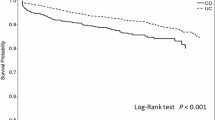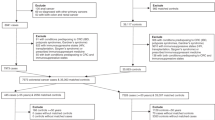Abstract
Purpose
Although the appendix has been suggested to play a role in maintaining the gut microbiome and immune system, the ramifications of appendectomy on the development inflammatory bowel disease, sepsis, and colorectal cancer are yet to be determined. The purpose of this study was to evaluate the potential long-term impacts of appendectomy, with a focus on inflammatory bowel disease, infection, and colorectal cancer, using the National Healthcare Insurance Service (NHIS) database of Korea.
Methods
The National Healthcare Insurance Service database in Korea was used for analysis. Adult patients who received appendectomy between 2005 and 2013 were identified. The control group consisted of patients who did not receive appendectomy were matched by baseline characteristics including comorbidities and frequency of healthcare resource utilization. The primary outcome was the incidence-rate ratio (IRR) of Crohn’s disease, ulcerative colitis, Clostridium difficile infection, sepsis, and colorectal cancer after appendectomy or the index date.
Results
We identified 914,208 patients who underwent appendectomy, and after matching with control patients, a total of 486,844 patients were included for analysis. Patients who underwent appendectomy showed a significantly higher incidence of Crohn’s disease (IRR 4.40, 95% confidence interval (CI) 3.78–5.13) and ulcerative colitis (IRR 1.78, 95% CI 1.63–1.93) compared to the control group during the 5-year follow-up period. The associations between appendectomy and Clostridium difficile infection, sepsis, and colorectal cancer were all found to be significant.
Conclusion
Patients who underwent appendectomy may be at increased risk for developing Crohn’s disease, ulcerative colitis, Clostridium difficile infection, sepsis, and colorectal cancer.



Similar content being viewed by others
Data Availability
Dr. Lee, Ms. Jang, and Dr. Ryu had full access to the study data and take responsibility for the integrity of the analysis.
References
Noudeh YJ, Sadigh N, Ahmadnia AY (2007) Epidemiologic features, seasonal variations and false positive rate of acute appendicitis in Shahr-e-Rey, Tehran. Int J Surg 5(2):95–98
Andersson RE (2007) The natural history and traditional management of appendicitis revisited: spontaneous resolution and predominance of prehospital perforations imply that a correct diagnosis is more important than an early diagnosis. World J Surg 31(1):86–92
Salminen P, Tuominen R, Paajanen H, Rautio T, Nordström P, Aarnio M, Rantanen T, Hurme S, Mecklin JP, Sand J, Virtanen J, Jartti A, Grönroos JM (2018) Five-year follow-up of antibiotic therapy for uncomplicated acute appendicitis in the APPAC randomized clinical trial. JAMA 320(12):1259–1265
Salminen P, Paajanen H, Rautio T, Nordström P, Aarnio M, Rantanen T, Tuominen R, Hurme S, Virtanen J, Mecklin JP, Sand J, Jartti A, Rinta-Kiikka I, Grönroos JM (2015) Antibiotic therapy vs appendectomy for treatment of uncomplicated acute appendicitis: the APPAC randomized clinical trial. JAMA 313(23):2340–2348
Addiss DG, Shaffer N, Fowler BS, Tauxe RV (1990) The epidemiology of appendicitis and appendectomy in the United States. Am J Epidemiol 132(5):910–925
Randal Bollinger R, Barbas AS, Bush EL, Lin SS, Parker W (2007) Biofilms in the large bowel suggest an apparent function of the human vermiform appendix. J Theor Biol 249(4):826–831
Zahid A (2004) The vermiform appendix: not a useless organ. J Coll Physicians Surg Pak 14(4):256–258
Fujihashi K, McGhee JR, Lue C, Beagley KW, Taga T, Hirano T, Kishimoto T, Mestecky J, Kiyono H (1991) Human appendix B cells naturally express receptors for and respond to interleukin 6 with selective IgA1 and IgA2 synthesis. J Clin Invest 88(1):248–252
Palestrant D, Holzknecht ZE, Collins BH, Parker W, Miller SE, Bollinger RR (2004) Microbial biofilms in the gut: visualization by electron microscopy and by acridine orange staining. Ultrastruct Pathol 28(1):23–27
Sonnenburg JL, Angenent LT, Gordon JI (2004) Getting a grip on things: how do communities of bacterial symbionts become established in our intestine? Nat Immunol 5(6):569–573
Bjerke K, Brandtzaeg P, Rognum TO (1986) Distribution of immunoglobulin producing cells is different in normal human appendix and colon mucosa. Gut 27(6):667–674
Andersson RE, Olaison G, Tysk C, Ekbom A (2003) Appendectomy is followed by increased risk of Crohn’s disease. Gastroenterology 124(1):40–46
Kaplan GG, Jackson T, Sands BE, Frisch M, Andersson RE, Korzenik J (2008) The risk of developing Crohn’s disease after an appendectomy: a meta-analysis. Am J Gastroenterol 103(11):2925–2931
Frisch M, Pedersen BV, Andersson RE (2009) Appendicitis, mesenteric lymphadenitis, and subsequent risk of ulcerative colitis: cohort studies in Sweden and Denmark. BMJ 338:b716
Radford-Smith GL (2008) What is the importance of appendectomy in the natural history of IBD? Inflamm Bowel Dis 14:S72–S74
Merchant R, Mower WR, Ourian A, Abrahamian FM, Moran GJ, Krishnadasan A, Talan DA (2012) Association between appendectomy and Clostridium difficile infection. J Clin Med Res 4(1):17–19
Andersson RE, Olaison G, Tysk C, Ekbom A (2001) Appendectomy and protection against ulcerative colitis. N Engl J Med 344(11):808–814
Song SO, Jung CH, Song YD, Park CY, Kwon HS, Cha BS, Park JY, Lee KU, Ko KS, Lee BW (2014) Background and data configuration process of a nationwide population-based study using the Korean national health insurance system. Diabetes Metab J 38(5):395–403
Quan H, Sundararajan V, Halfon P, Fong A, Burnand B, Luthi JC, Saunders LD, Beck CA, Feasby TE, Ghali WA (2005) Coding algorithms for defining comorbidities in ICD-9-CM and ICD-10 administrative data. Med Care 43(11):1130–1139
Oh SY, Cho S, Kim GH, Jang EJ, Choi S, Lee H, Ryu HG (2019) Incidence and Outcomes Of Sepsis in Korea: a nationwide cohort study from 2007 to 2016. Crit Care Med 47(12):e993–e998
Austin PC (2009) Using the standardized difference to compare the prevalence of a binary variable between two groups in observational research. Commun Stat Simul Comput 38(6):1228–1234
Fine JP, Gray RJ (1999) A proportional hazards model for the subdistribution of a competing risk. J Am Stat Assoc 94(446):496–509
Gray RJ (1988) A class of K-sample tests for comparing the cumulative incidence of a competing risk. Ann Stat 16(3):1141–1154
Girard-Madoux MJH, Gomez de Aguero M, Ganal-Vonarburg SC, Mooser C, Belz GT, Macpherson AJ, Vivier E (2018) The immunological functions of the appendix: an example of redundancy? Semin Immunol 36:31–44
Loh G, Blaut M (2012) Role of commensal gut bacteria in inflammatory bowel diseases. Gut Microbes 3(6):544–555
Bien J, Palagani V, Bozko P (2013) The intestinal microbiota dysbiosis and Clostridium difficile infection: is there a relationship with inflammatory bowel disease? Ther Adv Gastroenterol 6(1):53–68
Haak BW, Prescott HC, Wiersinga WJ (2018) Therapeutic potential of the gut microbiota in the prevention and treatment of sepsis. Front Immunol 9:2042
Brennan CA, Garrett WS (2016) Gut microbiota, inflammation, and colorectal cancer. Annu Rev Microbiol 70:395–411
Kaplan GG, Pedersen BV, Andersson RE, Sands BE, Korzenik J, Frisch M (2007) The risk of developing Crohn’s disease after an appendectomy: a population-based cohort study in Sweden and Denmark. Gut 56(10):1387–1392
Molodecky NA, Soon IS, Rabi DM et al (2012) Increasing incidence and prevalence of the inflammatory bowel diseases with time, based on systematic review. Gastroenterology 142(1):46–54 e42 quiz e30
Cosnes J, Carbonnel F, Beaugerie L, Blain A, Reijasse D, Gendre JP (2002) Effects of appendicectomy on the course of ulcerative colitis. Gut 51(6):803–807
Gardenbroek TJ, Pinkney TD, Sahami S, Morton DG, Buskens CJ, Ponsioen CY, Tanis PJ, Löwenberg M, van den Brink GR, Broeders IAMJ, Pullens PHJM, Seerden T, Boom MJ, Mallant-Hent RC, Pierik REGJM, Vecht J, Sosef MN, van Nunen AB, van Wagensveld BA, Stokkers PCF, Gerhards MF, Jansen JM, Acherman Y, Depla ACTM, Mannaerts GHH, West R, Iqbal T, Pathmakanthan S, Howard R, Magill L, Singh B, Htun Oo Y, Negpodiev D, Dijkgraaf MGW, RAM D’Haens G, Bemelman WA (2015) The ACCURE-trial: the effect of appendectomy on the clinical course of ulcerative colitis, a randomised international multicenter trial (NTR2883) and the ACCURE-UK trial: a randomised external pilot trial (ISRCTN56523019). BMC Surg 15:30
Im GY, Modayil RJ, Lin CT, Geier SJ, Katz DS, Feuerman M, Grendell JH (2011) The appendix may protect against Clostridium difficile recurrence. Clin Gastroenterol Hepatol 9(12):1072–1077
Chang JY, Antonopoulos DA, Kalra A, Tonelli A, Khalife WT, Schmidt TM, Young VB (2008) Decreased diversity of the fecal microbiome in recurrent Clostridium difficile-associated diarrhea. J Infect Dis 197(3):435–438
Wu MC, Tsou HK, Lin CL, Wei JC (2020) Incidence and risk of sepsis following appendectomy: a nationwide population-based cohort study. Sci Rep 10(1):10171
Wu SC, Chen WT, Muo CH, Ke TW, Fang CW, Sung FC (2015) Association between appendectomy and subsequent colorectal cancer development: an Asian population study. PLoS One 10(2):e0118411
Bendeck SE, Nino-Murcia M, Berry GJ, Jeffrey RB Jr (2002) Imaging for suspected appendicitis: negative appendectomy and perforation rates. Radiology 225(1):131–136
Kim K, Lee CC, Song KJ, Kim W, Suh G, Singer AJ (2008) The impact of helical computed tomography on the negative appendectomy rate: a multi-center comparison. J Emerg Med 34(1):3–6
Sugimoto T, Edwards D (1987) Incidence and costs of incidental appendectomy as a preventive measure. Am J Public Health 77(4):471–475
Lee JH, Park YS, Choi JS (2010) The epidemiology of appendicitis and appendectomy in South Korea: national registry data. J Epidemiol 20(2):97–105
Code availability
Microsoft Word
Author information
Authors and Affiliations
Contributions
Seohee Lee, Eun Jin Jang, Junwoo Jo, So Jung Park, and Ho Geol Ryu meet all the criteria for the definition of authorship and contributed substantially to the manuscript. Ho Geol Ryu is the correspondent author.
Corresponding author
Ethics declarations
Ethics approval
This study was approved by the Ethics Committee of the Seoul National University Hospital.
Conflict of interest
The authors declare no competing interests.
Additional information
Publisher’s note
Springer Nature remains neutral with regard to jurisdictional claims in published maps and institutional affiliations.
Rights and permissions
About this article
Cite this article
Lee, S., Jang, E.J., Jo, J. et al. Long-term impacts of appendectomy associated with increased incidence of inflammatory bowel disease, infection, and colorectal cancer. Int J Colorectal Dis 36, 1643–1652 (2021). https://doi.org/10.1007/s00384-021-03886-x
Accepted:
Published:
Issue Date:
DOI: https://doi.org/10.1007/s00384-021-03886-x




